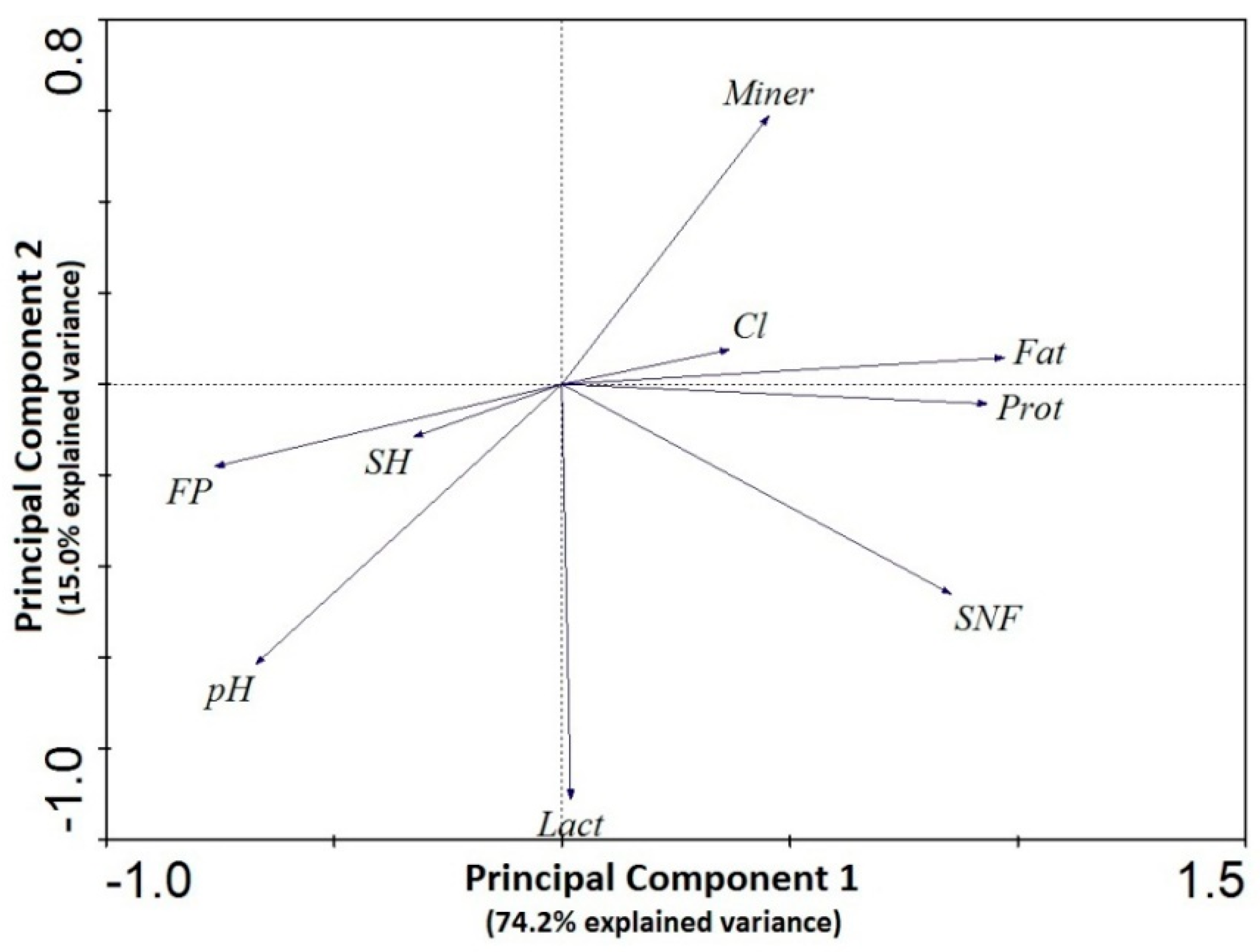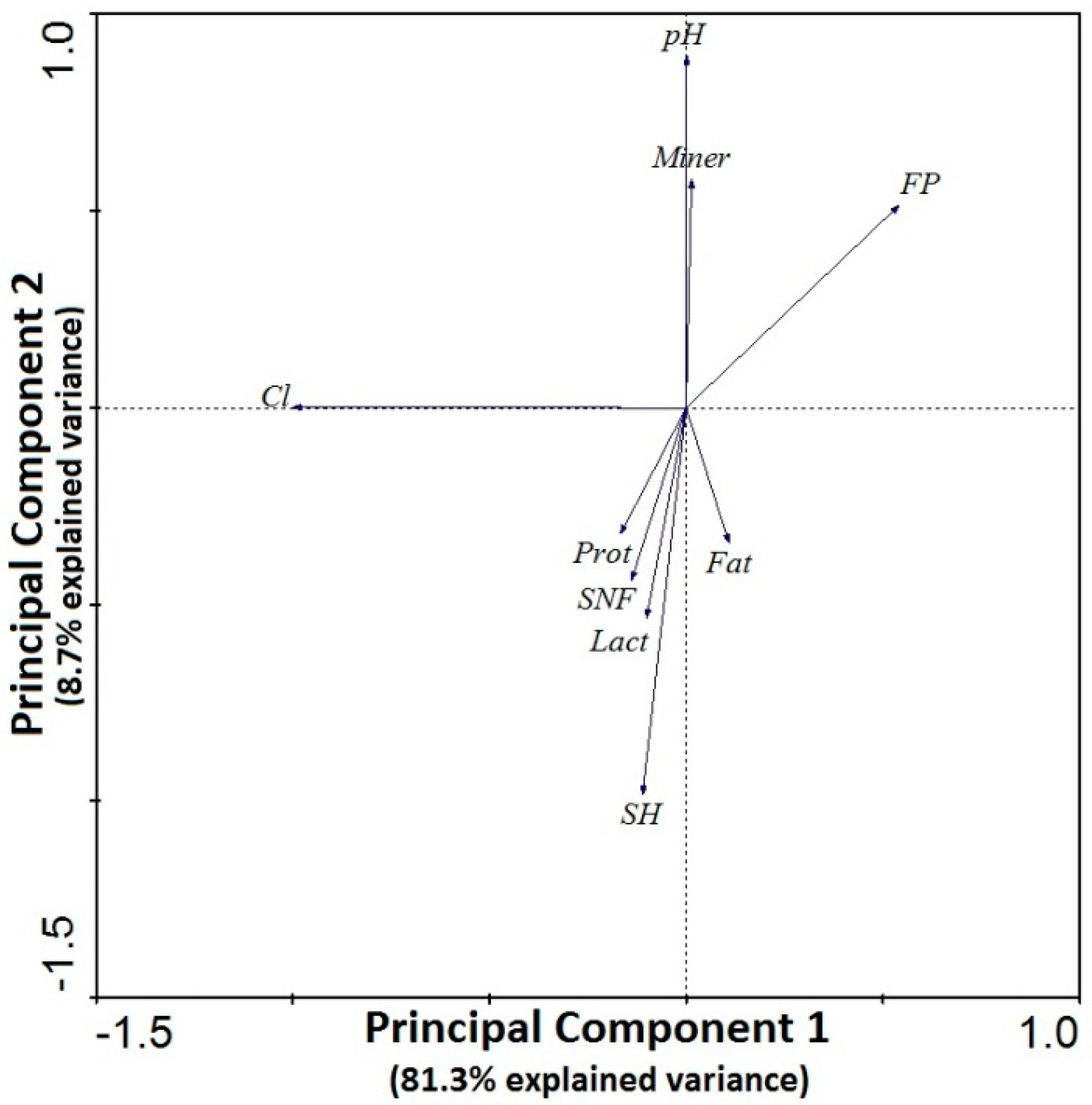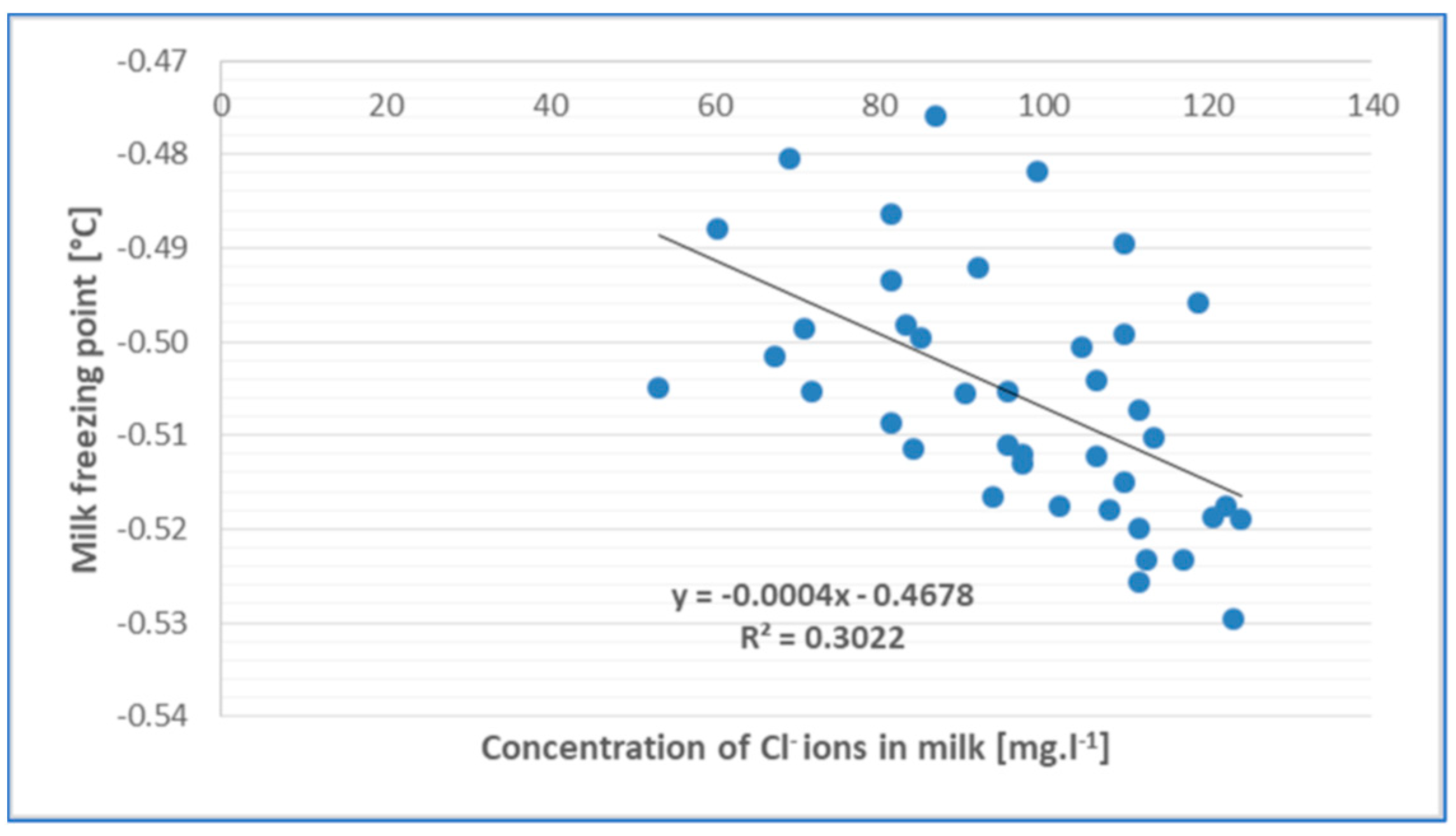Farm Level Milk Adulteration: Changes in the Physicochemical Properties of Raw Cow’s Milk after the Addition of Water and NaCl
Abstract
1. Introduction
2. Materials and Methods
2.1. Determination of Chloride Ions
2.2. Determination of Other Physical and Chemical Characteristics of Milk
2.3. Detection of Changes in the Selected Physicochemical Parameters Depending on the Amount of NaCl Added
2.4. Statistical Evaluation of the Results, Verification of the Selection Conformity, and the Principal Component Analysis (PCA)
3. Results
3.1. Chemical, Physical and Biological Composition of Milk in Relation to Chlorides
3.2. Validation of Laboratory Analysis Results
3.3. Relationship between Chlorides and Other Selected Milk Characteristics
4. Discussion
5. Conclusions
Author Contributions
Funding
Data Availability Statement
Acknowledgments
Conflicts of Interest
References
- Fan, S.; Brzeska, J. Sustainable food security and nutrition: Demystifying conventional beliefs. Glob. Food Secur. 2016, 11, 11–16. [Google Scholar] [CrossRef]
- Farrukh, M.U.; Bashir, M.K.; Rola-Rubzen, F. Exploring the sustainable food security approach in relation to agricultural and multi-sectoral interventions: A review of cross-disciplinary perspectives. Geoforum 2020, 108, 23–27. [Google Scholar] [CrossRef]
- Namany, S.; Govindan, R.; Alfagih, L.; McKay, G.; Al-Ansari, T. Sustainable food security decision-making: An agent-based modelling approach. J. Clean. Prod. 2020, 255, 120296. [Google Scholar] [CrossRef]
- Arnalte-Mur, L.; Ortiz-Miranda, D.; Cerrada-Serra, P.; Martinez-Gómez, V.; Moreno-Pérez, O.; Barbu, R.; Bjorkhaug, H.; Czekaj, M.; Duckett, D.; Galli, F.; et al. The drivers of change for the contribution of small farms to regional food security in Europe. Glob. Food Secur. 2020, 26, 100395. [Google Scholar] [CrossRef]
- Galli, F.; Grando, S.; Adamsone-Fiskovica, A.; Bjørkhaug, H.; Czekaj, M.; Duckett, D.G.; Almaas, H.; Karanikolas, P.; Moreno-Pérez, O.M.; Ortiz-Miranda, D.; et al. How do small farms contribute to food and nutrition security? Linking European small farms, strategies and outcomes in territorial food systems. Glob. Food Secur. 2020, 26, 100427. [Google Scholar] [CrossRef]
- Thorning, K.; Raben, A.; Tholstrup, T.; Soedamah-Muthu, S.S.; Givens, I.; Astrup, A. Milk and dairy products: Good or bad for human health? An assessment of the totality of scientific evidence. Food Nutr. Res. 2016, 60, 32527. [Google Scholar] [CrossRef]
- Santos, P.M.; Pereira-Filho, E.R.; Rodriguez-Saona, L.E. Rapid detection and quantification of milk adulteration using infrared microspectroscopy and chemometrics analysis. Food Chem. 2013, 138, 19–24. [Google Scholar] [CrossRef]
- Agrimonti, C.; Pirondini, A.; Marmiroli, M.; Marmiroli, N. A quadruplex PCR (qxPCR) assay for adulteration in dairy products. Food Chem. 2015, 187, 58–64. [Google Scholar] [CrossRef]
- Das, S.; Sivaramakrishna, M.; Biswas, K.; Goswami, B. A low cost instrumentation system to analyze different types of milk adulteration. ISA Trans. 2015, 56, 268–275. [Google Scholar] [CrossRef]
- Kamal, M.; Karoui, R. Analytical methods coupled with chemometric tools for determining the authenticity and detecting the adulteration of dairy products: A review. Trends Food Sci. Technol. 2015, 46, 27–48. [Google Scholar] [CrossRef]
- Kurajdová, K.; Táborecká-Petrovičová, J.; Kaščáková, A. Factors influencing milk consumption and purchase behavior: Evidence from Slovakia. Procedia Econ. Financ. 2015, 34, 573–580. [Google Scholar] [CrossRef]
- Liu, J.; Ren, J.; Liu, Z.-M.; Guo, B.-H. A new comprehensive index for discriminating adulteration in bovine raw milk. Food Chem. 2015, 172, 251–256. [Google Scholar] [CrossRef]
- Lohumi, S.; Lee, S.; Lee, H.; Cho, B.-K. A review of vibrational spectroscopic techniques for the detection of food authenticity and adulteration. Trends Food Sci. Technol. 2015, 46, 85–98. [Google Scholar] [CrossRef]
- Nieuwoudt, M.K.; Holroyd, S.E.; McGoverin, C.M.; Simpson, M.C.; Williams, D.E. Raman spectroscopy as an effective screening method for detecting adulteration of milk with small nitrogen-rich molecules and sucrose. J. Dairy Sci. 2016, 99, 2520–2536. [Google Scholar] [CrossRef]
- Poliana, M.; Santos, M.; Edenir, R.; Pereira-Filho, R.; Luiz, A.; Colnago, A. Detection and quantification of milk adulteration using time domain nuclear magnetic resonance (TD-NMR). Microchem. J. 2016, 124, 15–19. [Google Scholar] [CrossRef]
- Rebechi, S.R.; Vélez, M.A.; Vaira, S.; Perotti, M.C. Adulteration of Argentinean milk fats with animal fats: Detection by fatty acids analysis and multivariate regression techniques. Food Chem. 2016, 192, 1025–1032. [Google Scholar] [CrossRef]
- Zhao, K.; Liu, Y.; Zhang, Q. Dielectric behavior of adulterated milk with urea and water. J. Mol. Liq. 2019, 273, 37–44. [Google Scholar] [CrossRef]
- Singh, P.; Gandhi, N. Milk preservatives and adulterants: Processing, regulatory and safety issues. Food Rev. Int. 2015, 31, 236–261. [Google Scholar] [CrossRef]
- Ellis, D.I.; Brewster, V.L.; Dunn, W.B.; Allwood, J.W.; Golovanov, A.P.; Goodacre, R. Fingerprinting food: Current technologies for the detection of food adulteration and contamination. Chem. Soc. Rev. 2012, 41, 5706–5727. [Google Scholar] [CrossRef]
- Garcia, J.S.; Sanvido, G.B.; Saraiva, S.A.; Zacca, J.J.; Cosso, R.G.; Eberlin, M.N. Bovine milk powder adulteration with vegetable oils or fats revealed by MALDI-QTOF MS. Food Chem. 2012, 131, 722–726. [Google Scholar] [CrossRef]
- Tanzina, A.; Shoeb, A. Common milk adulteration and their detection techniques. Int. J. Food Contam. 2016, 3, 22. [Google Scholar] [CrossRef]
- Fischer, W.; Schilter, B.; Tritscher, A.; Stadler, R. Contaminants of milk and dairy products: Contamination resulting from farm and dairy practices. In Encyclopedia of Dairy Sciences; Academic Press: Cambridge, UK, 2011; pp. 887–897. ISBN 978-0-12-374407-4. [Google Scholar]
- Zajác, P.; Tomáška, M.; Murárová, A.; Čapla, J. Quality and safety of raw cow’smilk in Slovakia in 2011. Potravin. Slovak J. Food Sci. 2012, 6, 64–73. [Google Scholar] [CrossRef]
- Funke-Gerber GmbH. Determining dry mass in fluids especially milk using freezing point and turbidity measurements: Funke-Gerber GmbH DE-4206107. Food Control 1994, 5, 265. [Google Scholar] [CrossRef]
- Grufferty, M.B.; Fox, P.F. Effect of added NaCl on some physicochemical properties of milk. Ir. J. Food Sci. Technol. 1985, 9, 1–9. [Google Scholar]
- Van Hooydonk, A.C.M.; Hagedoorn, H.G.; Boerrigter, I.J. The effect of various cations on the renneting of milk. Neth. Milk Dairy J. 1986, 40, 369–390. [Google Scholar]
- Aoki, T.; Umeda, T.; Nakano, T. Effect of sodium chloride on the properties of casein micelles. Milchwissenschaft 1999, 54, 91–93. [Google Scholar]
- Famelart, M.H.; Le Graet, Y.; Raulot, K. Casein micelle dispersions into water, NaCl and CaCl2: Physicochemical characteristics of micelles and rennet coagulation. Int. Dairy J. 1999, 9, 293–297. [Google Scholar] [CrossRef]
- Gaucheron, F.; Le Graet, Y.; Briard, V. Effect of NaCl addition on the mineral equilibrium of concentrated and acidified casein micelles. Milchwissenschaft 2000, 55, 82–86. [Google Scholar]
- Gaucheron, F. The minerals of milk. Reprod. Nutr. Dev. 2005, 45, 473–483. [Google Scholar] [CrossRef]
- Van Den Berg, L. Changes in pH of milk during freezing and frozen storage. J. Dairy Sci. 1961, 44, 26–31. [Google Scholar] [CrossRef]
- Van Dijk, H.J.M. The properties of casein micelles. 4. The effect of the addition of NaCl, MgCl2 or NaOH on the partition of Ca, Mg and PO4 in cows’ milk. Neth. Milk Dairy J. 1991, 45, 241–251. [Google Scholar]
- Creamer, L.K. Water absorption by renneted casein micelles. Milchwissenschaft 1985, 40, 589–591. [Google Scholar]
- Huppertz, T.; Fox, P.F. Effect of NaCl on some physico-chemical properties of concentrated bovine milk. Int. Dairy J. 2006, 16, 1142–1148. [Google Scholar] [CrossRef]
- Morrissey, P.A. The heat stability of milk as affected by variations in the pH and milk salts. J. Dairy Res. 1969, 36, 343–351. [Google Scholar] [CrossRef]
- Fox, P.F.; Nash, B.M. Physico-chemical characteristics of casein micelles in dilute aqueous media. J. Dairy Res. 1979, 46, 357–363. [Google Scholar] [CrossRef]
- Chen, P.; Dong Chen, X.; Free, K.W. Measurement and data interpretation of the freezing point depression of milks. J. Food Eng. 1996, 30, 239–253. [Google Scholar] [CrossRef]
- Dong Chen, X.; Chen, P. Freezing of aqueous solution in a simple apparatus designed for measuring freezing point. Food Res. Int. 1996, 29, 723–729. [Google Scholar] [CrossRef]
- Odagiri, S.; Nickerson, T.A. Complexing of calcium by hexametaphosphate, oxalate, citrate, and ethylenediamine-tetraacetate in milk. II. Dialysis of milk containing complexing agents. J. Dairy S. 1965, 48, 19–22. [Google Scholar] [CrossRef]
- Le Graët, Y.; Brulé, G. Équilibres minéraux du lait: Influence du pH et de la force ionique. Lait 1993, 73, 51–60. [Google Scholar] [CrossRef][Green Version]
- Gaucheron, F.; Le Graët, Y.; Piot, M.; Boyaval, E. Determination of anions of milk by ion chromatography. Lait 1996, 76, 433–443. [Google Scholar] [CrossRef]
- Le Ray, C.; Maubois, J.L.; Gaucheron, F.; Brulé, G.; Pronnier, P.; Garnier, F. Heat stability of reconstituted casein micelle dispersions: Changes induced by salt addition. Lait 1998, 78, 375–390. [Google Scholar] [CrossRef]
- Sbodio, O.A.; Tercero, E.J.; Coutaz, R.; Revelli, G.R. Effect of renet and sodium chloride concentration on milk coagulation properties. CYTA-J. Food 2006, 5, 182–188. [Google Scholar] [CrossRef]
- Mao, X.Y.; Tong, P.S.; Gualco, S.; Vink, S. Effect of NaCl addition during diafiltration on the solubility, hydrophobicity, and disulfide bonds of 80% milk protein concentrate powder. J. Diary Sci. 2011, 95, 3481–3488. [Google Scholar] [CrossRef]
- Sikand, V.; Tong, P.S.; Walker, J.; Wang, T.; Rodriguez-Saona, L.E. Effect of storage temperature on the solubility of milk protein concentrate 80 (MPC80) treated with NaCl or KCl. J. Diary Sci. 2015, 99, 25–31. [Google Scholar] [CrossRef]
- Váryová, I.; Poláková, Z.; Košovská, I.; Ferenczi Vaňová, A.; Krajčírová, R. Analysis of development of raw cow milk prices in the conditions of the Slovak Republic. Potravin. Slovak J. Food Sci. 2019, 13, 906–914. [Google Scholar] [CrossRef][Green Version]
- Švikruhová, P.; Kapsdorferová, Z.; Kataniková, R.; Poláková, Z.; Grman, P. Identification of the needs of primary milk producers in the new common agricultural policy 2021–2027. Potravin. Slovak J. Food Sci. 2020, 14, 664–672. [Google Scholar] [CrossRef]
- Tančin, V.; Mikláš, Š.; Čobirka, M.; Uhrinčať, M.; Mačuhová, L. Factors affecting raw milk quality of dairy cows under practical conditions. Potravin. Slovak J. Food Sci. 2020, 14, 744–749. [Google Scholar] [CrossRef]
- Ter Braak, C.J.F.; Šmilauer, P. CANOCO Reference Manual and CanoDraw for Windows User’s Guide; Microcomputer Power: Ithaca, NY, USA, 2002; 500p. [Google Scholar]
- Lepš, J.; Šmilauer, P. Multivariate Analysis of Ecological Data Using CANOCO; Cambridge University Press: Cambridge, UK, 2003; 269p, ISBN 978-0-521-89108-0. [Google Scholar] [CrossRef]
- Walstra, P.; Jenness, R. Dairy Chemistry and Physics; Wiley Intersciences: New York, NY, USA, 1984; 467p, ISBN 978-0471097799. [Google Scholar]
- Holt, C. The milk salts and their interaction with casein. In Advanced Dairy Chemistry, Lactose, Water, Salts and Vitamins; Fox, P.F., Ed.; Chapman and Hall: London, UK, 1997; Volume 3, pp. 233–254. ISBN 0-412-63020-6. [Google Scholar] [CrossRef]
- Gaucheron, F. Minéraux et Produits Laitiers; Tec & Doc.–Lavoisier: Paris, France, 2004; 922p, ISBN 978-2743006419. [Google Scholar]
- Schmidt, K.; Stupar, J.; Shirley, J.; Adapa, S.; Sukup, D. Factors affecting titratable acidity in raw milk. In Proceedings of the Dairy Day 1996, Manhattan, KS, USA, 25 October 1996; pp. 60–62. Available online: http://hdl.handle.net/2097/8804 (accessed on 1 March 2016).
- Henno, M.; Ots, M.; Jõudu, I.; Kaart, T.; Kärt, O. Factors affecting the freezing point stability of milk from individual cows. Int. Dairy J. 2008, 18, 210–2015. [Google Scholar] [CrossRef]
- Kasemsumran, S.; Thanapase, W.; Kiatsoonthon, A. Feasibility of near-infrared spectroscopy to detect and to quantify adulterants in cow milk. Anal. Sci. 2007, 23, 907–910. [Google Scholar] [CrossRef]
- Santos, P.M.; Pereira-Filho, E.R.; Rodriguez-Saona, L.E. Application of hand-held and portable infrared spectrometers in bovine milk analysis. J. Agric. Food Chem. 2013, 61, 1205–1211. [Google Scholar] [CrossRef] [PubMed]
- Sharma, R.; Rajput, Y.S.; Barui, A.K. Detection of Adulterants in Milk—A Laboratory Manual; National Dairy Research Institute: Karnal, India, 2012; 110p. [Google Scholar]
- De la Fuente, M.A. Changes in the mineral balance of milk submitted to technological treatments. Trends Food Sci. Technol. 1998, 9, 417–428. [Google Scholar] [CrossRef]



| n | Milk Freezing Point (°C) | Minerals (g·100 g−1) | Chlorides (mg·100 g−1) | Fats (g·100 g−1) | Protein (g·100 g−1) | Lactose (g·100 g−1) | Solids-Not-Fat (g·100 g−1) | Somatic Cell Count (Thousands mL−1) | °SH | pH |
|---|---|---|---|---|---|---|---|---|---|---|
| 1 | −0.5280 | 0.65 | 47.87 | 4.07 | 3.38 | 4.78 | 8.81 | 459 | 7.20 | 6.65 |
| 2 | −0.5300 | 0.61 | 59.37 | 3.26 | 3.18 | 4.90 | 8.69 | 1012.5 | 7.40 | 6.60 |
| 3 | −0.5340 | 0.66 | 46.09 | 4.37 | 4.08 | 5.00 | 9.74 | 131.5 | 7.20 | 6.50 |
| 4 | −0.5190 | 0.79 | 81.55 | 4.64 | 3.87 | 4.21 | 8.86 | 2426.5 | 7.55 | 6.57 |
| 5 | −0.5345 | 0.72 | 74.46 | 4.18 | 3.49 | 4.42 | 8.63 | 390.5 | 6.95 | 6.39 |
| 6 | −0.4440 | 0.71 | 39.00 | 2.74 | 2.72 | 4.12 | 7.55 | 248 | 7.35 | 6.60 |
| 7 | −0.5350 | 0.65 | 74.41 | 4.10 | 3.34 | 4.73 | 8.72 | 365 | 7.25 | 6.36 |
| 8 | −0.5190 | 0.61 | 78.89 | 3.82 | 3.03 | 4.84 | 8.48 | 627 | 7.45 | 6.67 |
| 9 | −0.5225 | 0.75 | 86.84 | 3.65 | 3.29 | 4.68 | 8.72 | 186.5 | 7.00 | 6.53 |
| 10 | −0.5335 | 0.76 | 74.43 | 4.41 | 3.40 | 4.67 | 8.83 | 680.5 | 7.15 | 6.47 |
| 11 | −0.5330 | 0.79 | 86.83 | 3.91 | 3.64 | 4.58 | 9.00 | 158 | 7.30 | 6.62 |
| 12 | −0.5290 | 0.77 | 85.08 | 3.70 | 3.18 | 4.57 | 8.52 | 226 | 7.30 | 6.65 |
| 13 | −0.5300 | 0.77 | 88.59 | 3.77 | 3.42 | 4.61 | 8.79 | 188 | 7.25 | 6.67 |
| 14 | −0.5290 | 0.76 | 81.49 | 4.25 | 3.52 | 4.69 | 8.96 | 314.5 | 7.20 | 6.44 |
| 15 | −0.5320 | 0.77 | 88.62 | 3.52 | 3.59 | 4.61 | 8.97 | 3416.5 | 7.40 | 6.23 |
| 16 | −0.5895 | 0.84 | 92.16 | 6.20 | 4.36 | 4.53 | 9.73 | 298.5 | 7.10 | 5.41 |
| 17 | −0.6075 | 0.9 | 76.23 | 4.29 | 3.83 | 3.95 | 8.68 | 1175.5 | 7.15 | 5.37 |
| Basic Samples (without Added NaCl) | Samples with Added 0.0253 NaCl g·250 mL−1 H2O | Samples with Added 0.0506 NaCl g·250 mL−1 H2O | Samples with Added 0.0506 NaCl g·250 mL−1 H2O | |
|---|---|---|---|---|
| Arithmetic mean | −0.4964 °C | −0.5026 °C | −0.5083 °C | −0.5157 °C |
| Standard deviation | ±0.01 °C | ±0.01 °C | ±0.01 °C | ±0.01 °C |
| Number of samples | 10 | 10 | 10 | 10 |
| Degree of freedom | 9 | 9 | 9 | 9 |
| Sample | MFT1 | MFT2 | MFT3 | MFT4 | 1 Abs | 1 R/S | 2 Abs | 2 R/S | 3 Abs | 3 R/S |
|---|---|---|---|---|---|---|---|---|---|---|
| 1 | −0.511 | −0.518 | −0.523 | −0.530 | 0.007 | 8 | 0.012 | 4.5 | 0.019 | 5 |
| 2 | −0.488 | −0.493 | −0.501 | −0.507 | 0.005 | 2 | 0.013 | 7 | 0.019 | 5 |
| 3 | −0.500 | −0.504 | −0.51 | −0.518 | 0.004 | 1 | 0.01 | 2.5 | 0.018 | 2 |
| 4 | −0.498 | −0.505 | −0.505 | −0.519 | 0.007 | 8 | 0.007 | 1 | 0.021 | 9.5 |
| 5 | −0.499 | −0.506 | −0.513 | −0.519 | 0.007 | 8 | 0.014 | 9 | 0.02 | 7.5 |
| 6 | −0.502 | −0.509 | −0.517 | −0.52 | 0.007 | 8 | 0.015 | 10 | 0.018 | 2 |
| 7 | −0.476 | −0.482 | −0.489 | −0.496 | 0.006 | 4 | 0.013 | 7 | 0.02 | 7.5 |
| 8 | −0.480 | −0.486 | −0.492 | −0.499 | 0.006 | 4 | 0.012 | 4.5 | 0.019 | 5 |
| 9 | −0.505 | −0.512 | −0.518 | −0.526 | 0.007 | 8 | 0.013 | 7 | 0.021 | 9.5 |
| 10 | −0.505 | −0.511 | −0.515 | −0.523 | 0.006 | 4 | 0.01 | 2.5 | 0.018 | 2 |
| Compared Variants | Z | W | Wmean | SD from W | Value of p | Critical Value of W at n = 10 and α = 0.05 | Critical Value of W at n = 10 and α = 0.01 |
|---|---|---|---|---|---|---|---|
| MFT1:MFT2, MFT1:MFT3, MFT1:MFT4 | −2.8031 | 0 | 27.5 | 9.81 | 0.00512 | 8 | 3 |
Publisher’s Note: MDPI stays neutral with regard to jurisdictional claims in published maps and institutional affiliations. |
© 2022 by the authors. Licensee MDPI, Basel, Switzerland. This article is an open access article distributed under the terms and conditions of the Creative Commons Attribution (CC BY) license (https://creativecommons.org/licenses/by/4.0/).
Share and Cite
Fehér Pindešová, I.; Fehér, A.; Prus, P.; Zajác, P.; Prčík, M. Farm Level Milk Adulteration: Changes in the Physicochemical Properties of Raw Cow’s Milk after the Addition of Water and NaCl. Agriculture 2022, 12, 136. https://doi.org/10.3390/agriculture12020136
Fehér Pindešová I, Fehér A, Prus P, Zajác P, Prčík M. Farm Level Milk Adulteration: Changes in the Physicochemical Properties of Raw Cow’s Milk after the Addition of Water and NaCl. Agriculture. 2022; 12(2):136. https://doi.org/10.3390/agriculture12020136
Chicago/Turabian StyleFehér Pindešová, Iveta, Alexander Fehér, Piotr Prus, Peter Zajác, and Martin Prčík. 2022. "Farm Level Milk Adulteration: Changes in the Physicochemical Properties of Raw Cow’s Milk after the Addition of Water and NaCl" Agriculture 12, no. 2: 136. https://doi.org/10.3390/agriculture12020136
APA StyleFehér Pindešová, I., Fehér, A., Prus, P., Zajác, P., & Prčík, M. (2022). Farm Level Milk Adulteration: Changes in the Physicochemical Properties of Raw Cow’s Milk after the Addition of Water and NaCl. Agriculture, 12(2), 136. https://doi.org/10.3390/agriculture12020136







